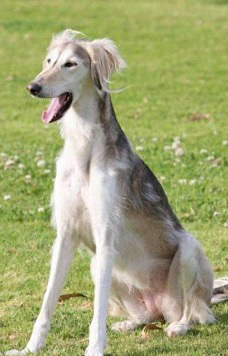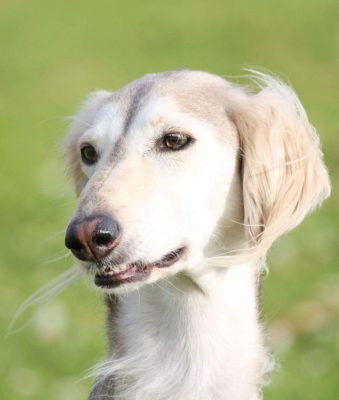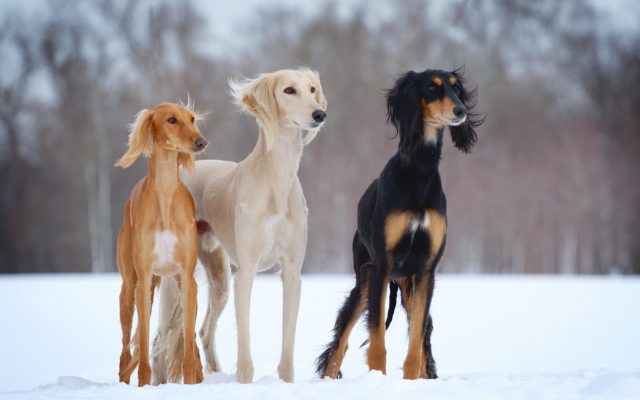Tazy

The character of the Tazy directly depends on the environment. Outdoors or during hunting, representatives of the breed are frisky, active, and able to catch any game. But as soon as they get into an apartment, they become lazy pets, which can only lie down and watch what’s going on. Affectionately, basins are similar to cats – they also like to rub up against their owner.
Table of Contents
Breed Information
| Another Name | – |
| Origin | Kazakhstan |
| Height | Males 60-70 cm Females 55-65 cm |
| Weight | 20-23 kg |
| Fur | Short |
| Color | Black, white, gray, red, straw |
| Lifespan | 12-15 years |
| FCI Classification | Breeds outside the FCI classification |
| Group | Hunting dogs |
| Price | From $130 |
Breed Photos
Origin History
The history of the breed dates back to the times of nomadic tribes of Central Asia. Back in the XVII century B.C., nomadic Turkmen tribes bred dogs and were recognized as innate breeders. Long and thorough selection helped Turkmens breed their representative of the aboriginal hound from the Arabian hound. After a while, the dog was named by the Iranian name of Tazy. The animal was distinguished by its ability to bear Central Asian frosts and work in the scorching sandy deserts. Thanks to this, the Tazy became the pride of the people.
The owners of the dogs could tell the pedigree up to the 16th tribe. They were the only animals that lived together with their owners in the same room. Wrapped in love and ate the same food as humans. During periods of frost and heat, the pets wore special clothes – ponies decorated with beads. If a dog got tired during a long hike, it could be carried on horseback. In Central Asia, Tazy were the only representatives of hunting dogs. It made them versatile hunters.
Turkmens were so delirious about the Tazy that they could give up 40 horses for it. Or give up a bride in exchange for a lazy. The breed was the main breadwinner in the family. Today, representatives of Tazy are not so popular. In most cases, they live with hunters away from kennel centers. Thus, Tazy breeding is done unofficially, significantly affecting the breed’s quality and the number of representatives.
Appearance
The size of Tazy is average or above average. Dry-type build with well-developed musculature. The head is long, wedge-shaped. The ears are floppy, set at the level of eyes or above. Big brown eyes. The tail is long, curled toward the end.
The breed has a short, soft coat. Only on the ears, it reaches five to six centimeters. Colors are allowed: gray, black, white, red, with and without a tan. Officially it is not recognized as a pied or tiger.
Character
The character of the Tazy directly depends on the environment. Outdoors or during hunting, representatives of the breed are frisky, active, and able to catch any game. But as soon as they get into an apartment, they become lazy pets, which can only lie down and watch what’s going on. Affectionately, basins are similar to cats – they also like to rub up against their owner.
Their pronounced innate ability to hunt makes them great defenders. No one will go near the house or the owner when the dog is near. At the same time, they are affectionate with children and quickly find contact. Dogs are leaders by nature and will not share space with other animals. They coexist best in country homes where they do not need to be chained up. The pet does not put up well with the restriction of innate activity. Can live in a spacious enclosure but with walks twice a day.
Care
As with any dog, it is important to take care of regular outings to fresh air. It is recommended to take long and active walks with the basin – the secret of the animal’s good physical condition. Once a week, comb the coat with a brush. You should not bathe Tazy often. Choose a mild shampoo and bathe it when necessary (after hunting or active training in the mud). After bathing, let the coat dry naturally. Brush your pet’s ears, teeth, and eyes once a week. If claws do not sharpen during walks, trim a few millimeters every month.
Training
Because of their innate leadership, representatives of the breed must be given enough attention. At the same time, show leadership qualities. Only in this case will the Tazy not get out on his head and not control the owner. Training should be regular and active. It is also worth introducing hunting games. Endurance and sighted animals can apprehend easily. For a long time, they can run at a speed of 12-15 km/h. At the same time, hunting for game, even faster. If you bought your dog as a hunting partner, training should begin at six months along with the adult breed.
Common Diseases
On average, dogs live from 12 to 16 years. Because of the small number of representatives, genetic diseases are not particularly studied. Tazy are known to be strong and active dogs but sensitive to any pain. It is not recommended to train the animal immediately after eating. It can lead to intestinal congestion. The following diseases occur:
- dermatitis;
- anemia;
- allergies;
- diseases of the cardiovascular system;
- rickets.
Nutrition
As far as nutrition is concerned, basins are undemanding. During active training, it is worth increasing portions one and a half times. Premium food or a natural diet is suitable. Choose lean meat, sea fish, porridges, vegetables, and fruits. The norm of meat products for the Tazy is about 500 g/day. It is forbidden to feed salty, smoked, sweet, and spicy food to the animal. During the season changes, add to the food vitamin and mineral complexes selected together with a specialist.



